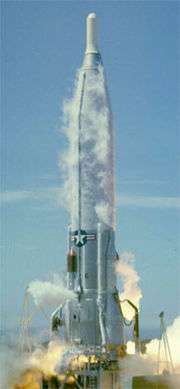Atlas E/F
 Launch of Atlas E/F X4 with a U.S. Navy payload | |
| Function |
Expendable launch system Sounding rocket |
|---|---|
| Manufacturer |
Convair General Dynamics Lockheed |
| Country of origin |
|
| Launch history | |
| Status | Retired |
| Launch sites | LC-576 & SLC-3, VAFB |
| Total launches | 65 |
| Successes | 56 |
| Failures | 9 |
| First flight | 4 August 1965 |
| Last flight | Saturday 24 March 2001 |
The Atlas E/F, also designated SB-1A was an American expendable launch system and sounding rocket built using parts of decommissioned SM-65 Atlas missiles. It was a member of the Atlas family of rockets.
The first stage was built using parts taken from decommissioned Atlas-E and Atlas-F missiles, with various solid propellant upper stages used, depending on the requirements of the payload.[1] The Atlas E/F was also used without an upper stage for a series of re-entry vehicle tests. On a single launch, an RM-81 Agena liquid-propellant upper stage was used.[2]
Variants
Atlas E/F
Thirty Atlas E/F rockets were launched without upper stages for ABRES and BMRS re-entry vehicle tests between 1965 and 1974. Three of these launches failed. Five ABRES launches were also conducted whilst the missiles were still operational, however these did not use the Atlas E/F configuration.
Atlas E/F-Agena
An RM-81 Agena upper stage was used on a former Atlas-F, to launch the Seasat-1 satellite on 27 June 1978.[2] This was the final flight of the Atlas-Agena. Previous Atlas-Agena launches had used Atlas D or Atlas SLV-3 rockets as first stages. The final Atlas - Agena was used on Atlas E/F.
Atlas E/F-Altair
An Atlas E/F with an Altair-3A upper stage was used to launch three Stacksat spacecraft on 11 April 1990. The rocket was capable of placing 210 kilograms (460 lb) of payload into low Earth orbit.
Atlas E/F-Burner
A Burner-2 upper stage was used on an Atlas E/F to launch the Radsat and Radcat satellites on 2 October 1972. The rocket had a payload capacity of 950 kilograms (2,090 lb) to low Earth orbit.
Atlas E/F-MSD
Atlas E/F rockets with MSD upper stages were used for four launches, with NOSS naval reconnaissance satellites between 1976 and 1980. The fourth of these launches failed when one of the booster unit engines shut down early. This configuration had a maximum payload capacity of 800 kilograms (1,800 lb) to LEO.
Atlas E/F-OIS
The OIS upper stage was used for two Atlas E/F launches in 1979 and 1985, with the Solwind and Geosat spacecraft respectively. The rocket could place 870 kilograms (1,920 lb) into low Earth orbit.
Atlas E/F-OV1
The Atlas E/F was used between 1968 and 1971 to launch four groups of OV1 satellites, using OV1 upper stages. Each payload had its own upper stage. Three of the launches carried two OV1 satellites, and one carried three. Two of the launches also carried secondary payloads. In this configuration, the rocket could place 363 kilograms (800 lb) into LEO.
Atlas E/F-PTS
The PTS was used to launch the NTS-1 satellite on 14 July 1974. The upper stage gave the vehicle a payload capacity of 295 kilograms (650 lb) to a medium Earth transfer orbit.
Atlas E/F-SGS
The SGS upper stage, which consisted of two series-burning solid rocket motors, was used on twelve Atlas E/F launches, with early GPS satellites. The first eight used the SGS-1, which could place 455 kilograms (1,003 lb) of payload into a medium Earth transfer orbit, whereas the last four used the more powerful SGS-2. The eighth launch failed.
Atlas E/F-Star
The Star was used to propel most of the other upper stages used on the Atlas E/F, however it was also used in its own right on several launches. A Star-17A was used in the launch of the RM-20 spacecraft on 12 April 1975, giving the rocket a LEO payload of 725 kilograms (1,598 lb), while the Star-37S-ISS was used to launch nineteen DMSP, NOAA and Tiros weather satellites between 1978 and 1995. With the Star-37 upper stage, the rocket could place 1,100 kilograms (2,400 lb) into a Sun-synchronous orbit. The RM-20 launch failed due to damage to the first stage, caused by the explosion of residual fuel in the flame trench during launch. Another launch failed due to stage separation occurring at the correct time despite the first stage burn being extended by fifty seconds to resolve an underperformance issue, the end result of which was the upper stage separating and igniting whilst the first stage was still firing.
Atlas E/F-Trident
The Atlas E/F was used with a Trident upper stage, between 1967 and 1971, for suborbital tests of re-entry vehicles. Nineteen were launched, of which two failed.
